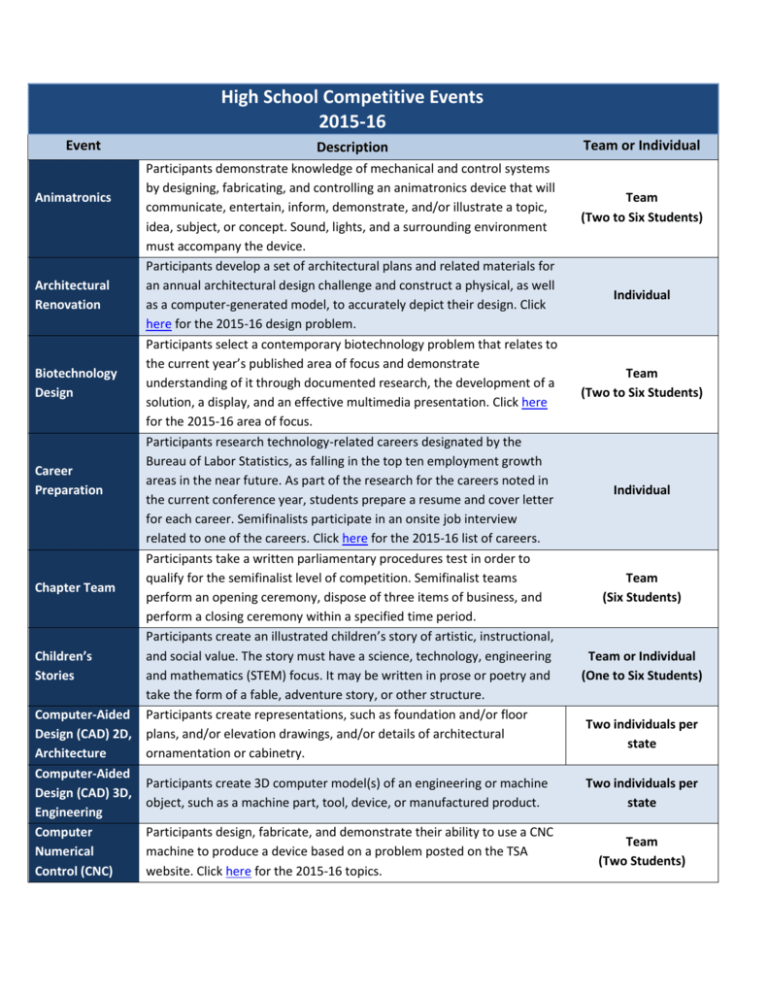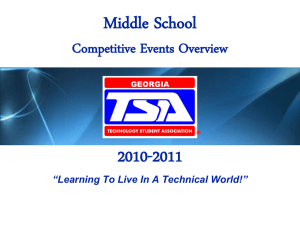File
advertisement

High School Competitive Events 2015-16 Event Animatronics Architectural Renovation Biotechnology Design Career Preparation Chapter Team Children’s Stories Computer-Aided Design (CAD) 2D, Architecture Computer-Aided Design (CAD) 3D, Engineering Computer Numerical Control (CNC) Description Participants demonstrate knowledge of mechanical and control systems by designing, fabricating, and controlling an animatronics device that will communicate, entertain, inform, demonstrate, and/or illustrate a topic, idea, subject, or concept. Sound, lights, and a surrounding environment must accompany the device. Participants develop a set of architectural plans and related materials for an annual architectural design challenge and construct a physical, as well as a computer-generated model, to accurately depict their design. Click here for the 2015-16 design problem. Participants select a contemporary biotechnology problem that relates to the current year’s published area of focus and demonstrate understanding of it through documented research, the development of a solution, a display, and an effective multimedia presentation. Click here for the 2015-16 area of focus. Participants research technology-related careers designated by the Bureau of Labor Statistics, as falling in the top ten employment growth areas in the near future. As part of the research for the careers noted in the current conference year, students prepare a resume and cover letter for each career. Semifinalists participate in an onsite job interview related to one of the careers. Click here for the 2015-16 list of careers. Participants take a written parliamentary procedures test in order to qualify for the semifinalist level of competition. Semifinalist teams perform an opening ceremony, dispose of three items of business, and perform a closing ceremony within a specified time period. Participants create an illustrated children’s story of artistic, instructional, and social value. The story must have a science, technology, engineering and mathematics (STEM) focus. It may be written in prose or poetry and take the form of a fable, adventure story, or other structure. Participants create representations, such as foundation and/or floor plans, and/or elevation drawings, and/or details of architectural ornamentation or cabinetry. Team or Individual Team (Two to Six Students) Individual Team (Two to Six Students) Individual Team (Six Students) Team or Individual (One to Six Students) Two individuals per state Participants create 3D computer model(s) of an engineering or machine object, such as a machine part, tool, device, or manufactured product. Two individuals per state Participants design, fabricate, and demonstrate their ability to use a CNC machine to produce a device based on a problem posted on the TSA website. Click here for the 2015-16 topics. Team (Two Students) Production Participants work together to prepare for a debate against a team from another chapter. Teams are instructed onsite to take either the pro or con side of a subtopic, which falls under a general topic that is designated annually. Click here for the 2015-16 topic/subtopics. Team (Two Students) Participants produce a portfolio containing a news release, a threecolumn newsletter, and a poster. Semifinalists work to solve an onsite problem demonstrating their abilities to use the computer to design and edit materials for in-house publication. Individual Digital Video Production Participants develop a digital video/film that focuses on the current year’s theme. Sound may accompany the film. Click here for the 2015-16 theme. Team (Two to Six Students) Dragster Design Participants design, produce working drawings for, and build a CO2powered dragster. Debating Technological Issues Desktop Publishing Engineering Design Essays on Technology Participants work to design and fabricate a device that will meet the specific needs of a person with a disability. Through use of a model/prototype, display, and design notebook, participants document and justify their identified problem and solution, as well as the solution’s impact on a member of their community and on society. Semifinalists justify and demonstrate the problem and solution in a timed presentation. Team (Three to Five Students) Participants write a synthesis essay to make insightful connections based on a current technological topic. Click here for the 2015-16 topic/subtopics. Individual Participants give a three to five minute speech 15 minutes after having Extemporaneous drawn a card on which a technology or TSA topic for a speech is written. Speech Immediately following their prep time, students give a three to five minute speech in front of a panel of judges. Fashion Design Flight Endurance Individual Individual Participants research, develop, and create garment designs, garment mock-ups, and portfolios that reflect the current year’s published theme. Semifinalists participate in an on-site event in which they present their potential garment designs to the judges. Click here for the 2015-16 theme. Team (Two to Four Members) Participants analyze flight principles with a rubber band-powered model aircraft. Individual Future Technology Teacher Manufacturing Prototype Music Production On Demand Video Photographic Technology Prepared Presentation Promotional Graphics SciVis Software Development Structural Design & Engineering System Control Participants research and select three accredited colleges or universities that offer technology education or engineering technology teacher preparation as a major. Each participant writes a one-page simulated college essay explaining why he/she wishes to become a technology education or engineering technology teacher and what would constitute success in the field. Participants also develop and present a lesson plan. Participants design and manufacture a prototype of a product (designated annually) and provide a description of how the product could be manufactured in a state-of-the-art American manufacturing facility. Click here for 2015-16 product guidelines. Participants produce an original musical piece that is designed to be played during the national TSA conference opening or closing general session. Participants write, shoot, and edit a sixty-second video onsite at the conference. Participants capture and process photographic and digital prints that depict the current year’s published theme. Semifinalists participate in an onsite event in which they capture digital images and utilize multimedia software to prepare and develop a media presentation during the annual conference. Click here for the 2015-16 theme. Participants deliver an oral presentation, which should include audio and/or visual enhancement, based on the theme for the current year’s conference. Click here for the 2015-16 theme. Individual Team (Two to Six Students) Team (Two to Six Students) Team (Two to Six Students) Individual Individual Participants develop and submit electronically a graphic design that can be used to promote participation in TSA-related interests. Click here for the 2015-16 event options. Individual Participants develop a visualization focusing on a subject or topic from one or more of the following areas: science, technology, engineering, or mathematics. Team (Two to Six Students) Participants work as part of a team to participate in the development, debugging, and documentation of a software design project using freely available software development toolkits. Through a multimedia presentation and documentation, the team explains its knowledge of the software development process. Team (Two to Six Students) Participants work as part of a team to build a structure that is posted on the TSA website. The structure is destructively tested and assessed to determine design efficiency. Semifinalists work on a construction problem that is a variation of the posted design. Click here for the 201516 theme. Team (Two Students) Participants work as part of a team onsite to develop a computer- Team Technology controlled model/solution to a problem, typically one from an industrial setting. Teams analyze the problem, build a computer-controlled mechanical model, program the model, explain the program and mechanical features of the model/solution, and write instructions for evaluators to operate the device. (Three Students) Technical Sketching and Application Participants complete a written test in order to qualify for the semifinalist level of competition. Semifinalists must demonstrate their ability to solve onsite engineering graphics problems using standard drafting techniques. Individual Technology Problem Solving Participants work together onsite to develop and create a solution to a problem using the limited materials provided and the tools allowed. Team (Two Students) Transportation Modeling Participants design and produce a scale model of a vehicle that fits the annual design problem. Individual VEX Robotics The TSA VEX Robotics Competition engages middle and high school students in science, technology, engineering, and mathematics (STEM) education through an exciting, head-to-head robotics contest that captures student attention, and both enhances and allows them to use their skills in STEM areas. In addition, the competition complements the existing technology-related competitive events offered by TSA at both levels of instruction. Team Video Game Design Participants develop an E+10-rated game that focuses on the subject of their choice. Team (Two to Six Students) Webmaster Participants (one team per chapter) are required to design, build, and launch a website that features their school's career and technology/engineering program, the TSA chapter, and the chapter’s ability to research and present a given topic pertaining to technology. Semifinalists participate in an onsite interview to demonstrate the knowledge and expertise gained during the development of the website, with an emphasis on web design methods and practices, as well as their research for the annual design topic. Click here for the 2015-16 design brief. Team (Three to Five Students)





